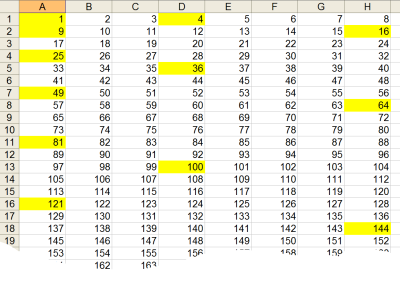Skip over navigation
Robert made a spreadsheet with eight columns. He arranged the numbers from 1 to 1000 in his spreadsheet, and then coloured in all the square numbers.
Here is a picture showing the first few rows of Robert's spreadsheet:

Robert noticed some interesting patterns beginning to emerge.
Why not create your own copy of Robert's spreadsheet and see what patterns you notice?
Can you explain the patterns you find?
Will the patterns continue? How can you be sure?



Or search by topic
Number and algebra
Geometry and measure
Probability and statistics
Working mathematically
Advanced mathematics
For younger learners
Robert's Spreadsheet
Age 14 to 16
Challenge Level 





Robert made a spreadsheet with eight columns. He arranged the numbers from 1 to 1000 in his spreadsheet, and then coloured in all the square numbers.
Here is a picture showing the first few rows of Robert's spreadsheet:

Robert noticed some interesting patterns beginning to emerge.
Why not create your own copy of Robert's spreadsheet and see what patterns you notice?
Can you explain the patterns you find?
Will the patterns continue? How can you be sure?
You may also like
Odd Differences
The diagram illustrates the formula: 1 + 3 + 5 + ... + (2n - 1) = n² Use the diagram to show that any odd number is the difference of two squares.
Triangular Triples
Show that 8778, 10296 and 13530 are three triangular numbers and that they form a Pythagorean triple.
Iff
Take a triangular number, multiply it by 8 and add 1. What is special about your answer? Can you prove it?

